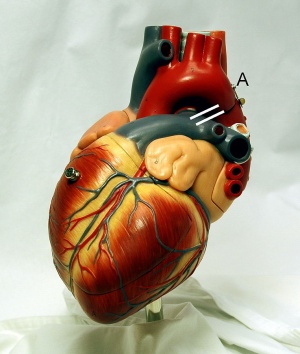Physical Activity and Cardiovascular Disease: Difference between revisions
Wendy Walker (talk | contribs) No edit summary |
Wendy Walker (talk | contribs) No edit summary |
||
| Line 29: | Line 29: | ||
=== PA effect on Hypertension/Blood Pressure === | === PA effect on Hypertension/Blood Pressure === | ||
Studies show that there is an inverse relationship between physical activity and the incidence of hypertension, with inactive individuals having a 30-50% greater risk of high blood pressure/hypertension than fit and active individuals<ref>Whelton SP, Chin A, Xin X, He J. (2013) Effect of aerobic exercise on blood pressure: A meta-analysis of randomized, controlled trials. Ann Int Med. 136 (7): 493-503</ref>. | Studies show that there is an inverse relationship between physical activity and the incidence of hypertension, with inactive individuals having a 30-50% greater risk of high blood pressure/hypertension than fit and active individuals<ref>Whelton SP, Chin A, Xin X, He J. (2013) Effect of aerobic exercise on blood pressure: A meta-analysis of randomized, controlled trials. Ann Int Med. 136 (7): 493-503</ref>. | ||
The frequency of exercise has a significant effect: the acute effect of PA causes a reduction in blood pressure lasting 4 to 10 hours; therefore, daily activity may achieve clinically significant improvement<ref name=":0">Cornelissen VA, Smart NA. (2013) | |||
Exercise training for blood pressure: A systemic review and meta-analysis. | |||
Journal of American Heart Association. 2 (1) e004473. doi:10.1161/JAHA.112.004473 | |||
</ref>, | |||
Aerobic fitness training has the greatest benefit, but dynamic resistance and isometric resistance at moderate intensity training has a smaller benefit<ref name=":0" /><ref>American College of Sports medicine. | |||
Position stand. (1993) Physical activity, physical fitness and hypertension. | |||
Medicine and Science in Sport and Exercise. 25:i-x | |||
</ref><ref>Cornelissen VA. Fagard RH. (2005) | |||
Effect of resistance training on resting blood pressure. A meta-analysis of randomised controlled trials. Journal of Hypertension. 23:251-9 | |||
</ref>22, 23,24 | |||
=== Exercise in Coronary Artery Disease === | === Exercise in Coronary Artery Disease === | ||
Revision as of 23:58, 12 May 2018
Original Editor - Nadja Thöner
Top Contributors - Nadja Thöner, Laura Ritchie, Wendy Walker, Kim Jackson, Lucinda hampton, Admin, Vidya Acharya, Uchechukwu Chukwuemeka, Tarina van der Stockt, Evan Thomas, Michelle Lee, Adam Vallely Farrell, Rucha Gadgil, Lauren Lopez and 127.0.0.1
Definition [1][edit | edit source]
Cardiovascular diseases are a group of disorders of the heart and blood vessels and include:
- coronary heart disease: disease of the blood vessels supplying the heart muscle
- cerebrovascular disease: disease of the blood vessels supplying the brain
- peripheral arterial disease: disease of blood vessels supplying the arms and legs
- rheumatic heart disease: damage to the heart muscle and heart valves from rheumatic fever, caused by streptococcal bacteria
- congenital heart disease: malformations of heart structure existing at birth
- deep vein thrombosis and pulmonary embolism: blood clots in the leg veins, which can dislodge and move to the heart and lungs
Heart attacks and strokes are usually acute events and are mainly caused by a blockage that prevents blood from flowing to the heart or brain. The most common reason is a build-up of fatty deposits on the inner walls of the blood vessels. Strokes can be caused by bleeding from a blood vessel in the brain or by blood clots.
Physical Activity Effects on Cardiovascular Diseases[edit | edit source]
The benefits of exercise with 1000kcal per week in secondary prevention decreases the all cause mortality around 20-30% [2] Physical activity improves systolic blood pressure, angina symptoms and exercises tolerance in patients without revascularization [3]. For patients with revascularization physical activity improves quality of lives and exercise tolerance, as well as 29% of cardiac events and around 20% lower re-admission rates[4].
However, it is important to note that only current physical activity is protective – sports participation in youth does not provide protection in later life unless activity is maintained[5].
PA effect on Hypertension/Blood Pressure[edit | edit source]
Studies show that there is an inverse relationship between physical activity and the incidence of hypertension, with inactive individuals having a 30-50% greater risk of high blood pressure/hypertension than fit and active individuals[6].
The frequency of exercise has a significant effect: the acute effect of PA causes a reduction in blood pressure lasting 4 to 10 hours; therefore, daily activity may achieve clinically significant improvement[7],
Aerobic fitness training has the greatest benefit, but dynamic resistance and isometric resistance at moderate intensity training has a smaller benefit[7][8][9]22, 23,24
Exercise in Coronary Artery Disease[edit | edit source]
The evidence for benefit of exercise in Coronary Artery Disease (CAD) is compelling and it has been conclusively established that exercise is indicated in the primary and secondary prevention of CAD. Studies demonstrate that the benefits of exercise are greater than the results of PCI (Percutaneous Coronary Intervention) techniques.
In one study of 101 men with stable CAD[10], over a two year period, regular exercise intervention outperformed PCI on all measures:
- "Event free survival" rates after 24 months were 78% in the exercise group versus 62% in the PCI cohort (P = 0.039).
- At two years, maximal oxygen consumption (VO2max) had increased by 10% in the exercise group versus 7% in the PCI group.
- Inflammatory markers improved in the exercise cohort: high-sensitive C-reactive protein levels and interleukin-6 levels were significantly reduced after two years of exercise by 41 and 18%, respectively, whereas no relevant changes were observed in the PCI group.
Exercise in Chronic Heart Failure[edit | edit source]
The benefits of physical exercise in patients with Chronic Heart Failure (CHF) have been identified in many studies and in a large meta-analysis published in 2006, the authors came to the following conclusions:
- exercise training in stable patients with mild to moderate CHF results in statistically significant improvements in maximum heart rate, maximum cardiac output, peak VO2, anaerobic threshold, 6 minute walk test and HRQL (quality of life questionnaire).
Symptoms of Cardiovascular Events [11][edit | edit source]
| [12] |
The classic symptoms of a cardiovascular event include;
- Chest discomfort (pressure, squeezing, fullness, pain)
- Discomfort in one or both arms, back, jaw or stomach
- Shortness of breath
- Cold sweat
- Nausea
- Lightheadedness
Women may not experience the classic symptoms above. Instead, they are more likely to experience the following;
- Unusual fatigue
- Sleep disturbances
- Weakness
- Shortness of breath
- Nausea/vomiting
- Back or jaw pain. [13]
Resource[edit | edit source]
The American Heart Association designed a Healthy Heart Quiz: Are you able to recognize a Heart Attack? They have also produced a useful graphic on this topic.
Prodromal Symptoms[edit | edit source]
A 10mmHg decrease in systolic blood pressure was associated with a higher risk for fatal and non-fatal cardiovascular events.[14]
Increased long-term variability in systolic blood pressure was associated with a higher risk for cardiovascular events, mortality and disease.[15]
Exercise Prescription[16][edit | edit source]
The American College of Sports Medicine (ACSM) published guidelines which were based on their traditional exercise guidelines but adapted for the physiological differences in patients with CAD compared to healthy individuals. Patients with CAD should perform everyday physical activity as well as supervised exercise lessons.
| [17] |
Mode[edit | edit source]
- Continuous exercise using large muscle groups (e.g. walking, swimming, group aerobics) fosters cardiovascular endurance. Upper extremity exercises (e.g. using an arm ergometer) may be useful for people with musculoskeletal problems in their lower extremities.
- Resistance exercises should be provided in a circuit training approach. 10-12 exercises using 10-12 repetitions with sufficient resistance that can be performed comfortably. Cross-training is possible as well.
Frequency[edit | edit source]
- A minimum of three nonconsecutive days per week
- With the increased frequency of exercise, the risk of musculoskeletal injuries increases
Duration[edit | edit source]
- 10 minute warm-up and cool-down phases, including stretching and flexibility exercises.
- 20-40 minute continuous or interval cardiovascular exercise. Interval training may be useful for people with peripheral vascular disease and intermittent claudication.
Intensity[edit | edit source]
Cardiovascular exercise in supervised programs should be of moderate intensity. Intensity can be determined using various methods;
- 40-85% VO2 max
- 40-85% maximal heart rate reserve (HRmax - resting heart rate) X 40-85% + resting heart rate
- 55-90% of HRmax
- The Rating of Perceived Exertion (RPE) is appropriate to monitor exercise intensity
Progression[edit | edit source]
- Slow progression of exercise duration and intensity
Monitoring[edit | edit source]
- Patient observation
- Measure heart rate and rhythm
- Measure blood pressure when clinically indicated (depending on the patient-specific risks for exercise-related complications)
- Patients who exercise without direct supervision should exercise at a lower intensity
Contraindications for Exercises[edit | edit source]
Patients should exercise at a sub-symptom threshold to avoid provoking myocardial ischemia, significant arrhythmias or symptoms of exercise intolerance. Patients at higher risk should exercise at lower levels of intensity.
Absolute contraindications to exercise;[18]
- Uncontrolled or poorly controlled asthma
- Cancer or blood disorders when treatment or disease cause leukocytes below 0.5 x10/L, haemoglobin below 60g/L or platelets below 20 x 10/L
- COPD: Patients are required to be stable before training and oxygen saturation levels should be above 88-90%.
- Diabetes if blood glucose is >13 mmol/L or <5.5 mmol/L
- Patients with diabetic peripheral or autonomic neuropathy or foot ulcers should avoid weight bearing exercise
- Any diabetic with acute illness or infection
- Heart disease - acute myocardial infarction or unstable angina until stable for at least 5 days, dyspnoea at rest, pericarditis, myocarditis, endocarditis, symptomatic aortic stenosis, cardiomyopathy, unstable or acute heart failure, uncontrolled tachycardia
- Hypertension - resting blood pressures of a systolic >180mmHg or diastolic >100mmHg or higher should receive medication before regular physical activity with particular restrictions on heavy strength conditioning, which can create particularly high pressures
- Osteoporosis - avoid activities with a high risk of falling
- Fever - should be settled to avoid a risk of developing myocarditis
- Unexplained dizzy spells
- Acute pulmonary embolus or pulmonary infarction
- Excessive or unexplained breathlessness on exertion
- Any acute severe illness
Risk of Exercises[edit | edit source]
Risk of Exercise for patients with coronary heart disease: acute myocardial infarction, cardiac arrest and sudden death.
Incidence in supervised cardiac rehabilitation programs are:
- 1 myocardial infarction per 294,000 patient hours
- 1 cardiac arrest per 112, 000 patient hours
- 1 death per 784,000 patient hours.
Over 80% of persons who reported cardiac arrest symptoms while exercising have been successfully resuscitated with prompt defibrillation [19].
Exercises and Medications[edit | edit source]
Exercise response to cardiac medications (Heart online)
Resources[edit | edit source]
- CVD News and Research Updates (The Heart and Stroke Foundation South Africa)
- Measuring Physical activity Intensity https://www.cdc.gov/physicalactivity/basics/measuring/ http://www.who.int/dietphysicalactivity/physical_activity_intensity/en/ Exercise Testing
- The Motivate2Move website, created by Wales Deanery, has a useful section on activity and cardiorespiratory health.
References[edit | edit source]
- ↑ WHO. Region Office for Europe. 2017. http://www.euro.who.int/en/health-topics/noncommunicable-diseases/cardiovascular-diseases/cardiovascular-diseases2/definition-of-cardiovascular-diseases [Accessed 2/25/2017].
- ↑ Lee I-M, Skerett PJ: Physical activity and all-cause mortality—What is the dose response relation? Med. Sci Sports exerc33(6Suppl):S459,2001.
- ↑ Hambrecht R. WoEffects of exercise on coronary endothelial function in patients with coronary artery disease. Am J Cadriol 90:124, 2002.
- ↑ Belardinelli R, Paolini I, Cianci G, et al:Exercise training intervention after coronary angioplasty: The ETICA trial. J Am Coll Cardiol 37:1891, 2001.
- ↑ Sesso HD1, Paffenbarger RS Jr, Lee IM. Physical activity and coronary heart disease in men: The Harvard Alumni Health Study. Circulation. 2000 Aug 29;102(9):975-80.
- ↑ Whelton SP, Chin A, Xin X, He J. (2013) Effect of aerobic exercise on blood pressure: A meta-analysis of randomized, controlled trials. Ann Int Med. 136 (7): 493-503
- ↑ 7.0 7.1 Cornelissen VA, Smart NA. (2013) Exercise training for blood pressure: A systemic review and meta-analysis. Journal of American Heart Association. 2 (1) e004473. doi:10.1161/JAHA.112.004473
- ↑ American College of Sports medicine. Position stand. (1993) Physical activity, physical fitness and hypertension. Medicine and Science in Sport and Exercise. 25:i-x
- ↑ Cornelissen VA. Fagard RH. (2005) Effect of resistance training on resting blood pressure. A meta-analysis of randomised controlled trials. Journal of Hypertension. 23:251-9
- ↑ Claudia Walther, Sven Möbius-Winkler, Axel Linke, Mathias Bruegel, Joachim Thiery, Gerhard Schuler, Rainer Halbrecht. "Regular exercise training compared with percutaneous intervention leads to a reduction of inflammatory markers and cardiovascular events in patients with coronary artery disease". European Journal of Preventative Cardiology, Vol 15, Issue 1, 2008
- ↑ American Heart Association. Life is why. Warning signs of a Heart Attack.2017.https://www.heart.org/HEARTORG/Conditions/HeartAttack/WarningSignsofaHeartAttack/Warning-Signs-of-a-Heart-Attack_UCM_002039_Article.jsp [Accessed 2/26/2017].
- ↑ The UNIVERSE. Early Signs of Heart Attack (Must Know). Available from: http://www.youtube.com/watch?v=9tj-M04gfA4 [last accessed 01/10/17]
- ↑ McSweeney,J.C., Cody, M., O`Sulivan, P., Elberson, K. Et al.Women’s Early Warning Symptoms of Acute Myocardial Infarction. Circulation. 2003;108:2619-2623. http://circ.ahajournals.org/content/108/21/2619 [Accessed 2/26/2017].
- ↑ Barlow, P.A., Otahal,P.O., Schultz, M.G. Et al. Low exercise blood pressure and risk of cardiovascular events and all-cause mortality: Systematic review and meta-analysis. 2014. Atherosclerosis;237(1). 13-22. http://www.atherosclerosis-journal.com/article/S0021-9150(14)01356-2/abstract [Accessed 2/25/2017].
- ↑ Stevens, S.L., Wood, S., Koshiaris, C. Et al.. Blood pressure variability and cardiovascular disease: systematic review and meta-analysis. BMJ.2016;354:i4098 http://dx.doi.org/10.1136/bmj.i4098 http://www.bmj.com/content/bmj/354/bmj.i4098.full.pdf [Accessed 2/25/2017].
- ↑ American College of Sports Medicine Position Stand. Exercise for patients with coronary artery disease. Me. Sci. Sports Exerc. 1994;26 (3): i-v.
- ↑ East Cheshire NHS Trust. Cardiac rehabilitation exercise video - from the Cardiac Rehab Team. Available from: http://www.youtube.com/watch?v=1iyBNlXA4vM [last accessed 01/10/17]
- ↑ Revalidation Support Unit (RSU), PGMDE. Neuadd Merionnydd. Wales. Motivate 2 Move.https://gpcpd.walesdeanery.org/index.php/starting-to-exercise/contraindications [Accessed 2/25/2017].
- ↑ Thompson, P.D. Et al. Exercise and Acute Cardiovascular Events: Placing the Risks into Perspective.MEDICINE & SCIENCE IN SPORTS & EXERCISE. 2007; DOI: 10.1249/mss.0b013e3180574e0e Available under: http://www.acsm.org/public-information/position-stands [Accessed 2/25/2017].










